职称英语理工类A级考试真题及答案(部分)
- 格式:doc
- 大小:41.00 KB
- 文档页数:10

职称英语等年级考试理
工类A级试题及答案 Company number【1089WT-1898YT-1W8CB-9UUT-92108】
【经典资料,WORD文档,可编辑修改】
【经典考试资料,答案附后,看后必过,WORD文档,可修改】
2015年职称英语等级考试理工类A级试题及答案
第1部分:词汇选项 (第1~15题,每题1分,共15分)
下面共有15个句子,每个句子中均有1个词或短语画有底横线,请从每个句子后面所给的4个选项中选择1个与画线部分意义最相近的词或短语。
请将答案涂在答题卡相应的
位置上。
1 It is obvious that he will win the game.
A likely
B possible
C clear
D strange
2 There is no risk to public health.
A point
B danger
C chance
D hope
3 Did anyone call me when was out?。
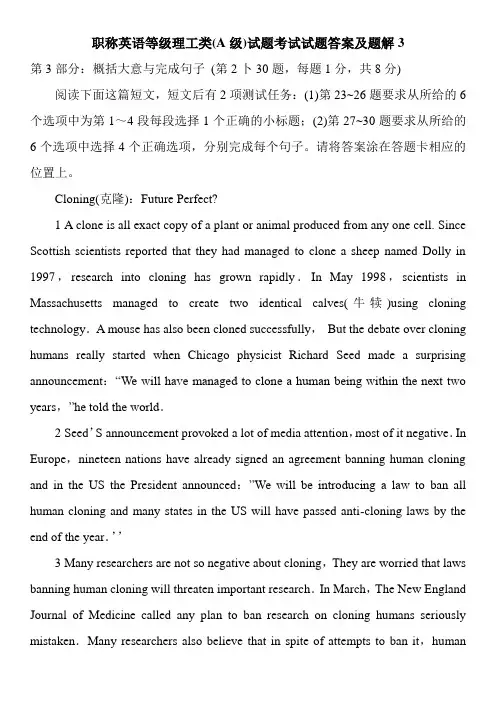
职称英语等级理工类(A级)试题考试试题答案及题解3第3部分:概括大意与完成句子(第2卜30题,每题1分,共8分) 阅读下面这篇短文,短文后有2项测试任务:(1)第23~26题要求从所给的6个选项中为第1~4段每段选择1个正确的小标题;(2)第27~30题要求从所给的6个选项中选择4个正确选项,分别完成每个句子。
请将答案涂在答题卡相应的位置上。
Cloning(克隆):Future Perfect?1 A clone is all exact copy of a plant or animal produced from any one cell. Since Scottish scientists reported that they had managed to clone a sheep named Dolly in 1997,research into cloning has grown rapidly.In May 1998,scientists in Massachusetts managed to create two identical calves(牛犊)using cloning technology.A mouse has also been cloned successfully,But the debate over cloning humans really started when Chicago physicist Richard Seed made a surprising announcement:“We will have managed to clone a human being within the next two years,”he told the world.2 Seed’S announcement provoked a lot of media attention,most of it negative.In Europe,nineteen nations have already signed an agreement banning human cloning and in the US the President announced:”We will be introducing a law to ban all human cloning and many states in the US will have passed anti-cloning laws by the end of the year.’’3 Many researchers are not so negative about cloning,They are worried that laws banning human cloning will threaten important research.In March,The New England Journal of Medicine called any plan to ban research on cloning humans seriously mistaken.Many researchers also believe that in spite of attempts to ban it,humancloning will have become routine by 2010 because it is impossible to stop the progress of science.4 Is there reason to fear that cloning will lead to a nightmare world? The public has been bombarded(轰炸)with newspaper articles,television shows and films,as well as cartoons.Such information is often misleading,and makes people wonder what on earth the scientists will be doing next.Within the next five to ten years scientists will probably have found a way of cloning humans. It could be that pretty soon we will be able to choose the person that we want our child to look like.But how would it feel to be a clone among hundreds,the anti-cloners ask.Pretty cool, answer the pr-cloners(赞成克隆的人).第4部分:阅读理解(第31~45题,每题3分,共45分)下面有3篇短文,每篇短文后有5道题,每道题后面有4个选项。
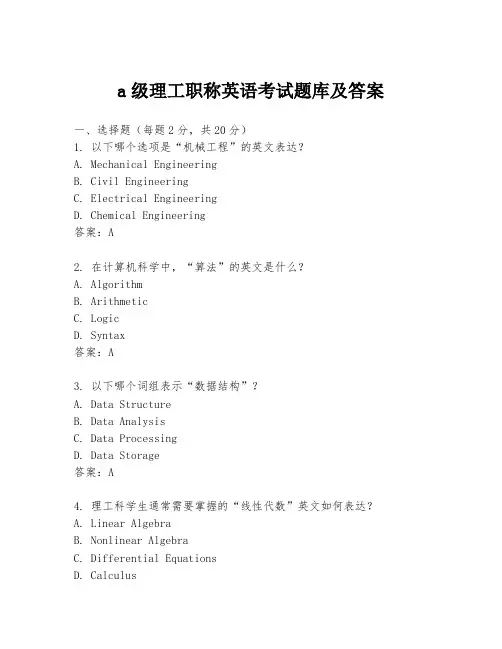
a级理工职称英语考试题库及答案一、选择题(每题2分,共20分)1. 以下哪个选项是“机械工程”的英文表达?A. Mechanical EngineeringB. Civil EngineeringC. Electrical EngineeringD. Chemical Engineering答案:A2. 在计算机科学中,“算法”的英文是什么?A. AlgorithmB. ArithmeticC. LogicD. Syntax答案:A3. 以下哪个词组表示“数据结构”?A. Data StructureB. Data AnalysisC. Data ProcessingD. Data Storage答案:A4. 理工科学生通常需要掌握的“线性代数”英文如何表达?A. Linear AlgebraB. Nonlinear AlgebraC. Differential EquationsD. Calculus答案:A5. “人工智能”在英文中的正确表达是?A. Artificial IntelligenceB. Natural IntelligenceC. Human IntelligenceD. Machine Learning答案:A6. “热力学”的英文术语是什么?A. ThermodynamicsB. KineticsC. MechanicsD. Statics答案:A7. 在物理学中,“量子力学”对应的英文是?A. Quantum MechanicsB. Classical MechanicsC. Statistical MechanicsD. Relativity答案:A8. “材料科学”的英文表达是?A. Material ScienceB. Applied ScienceC. Natural ScienceD. Physical Science答案:A9. “电气工程”的英文术语是什么?A. Electrical EngineeringB. Electronic EngineeringC. Mechanical EngineeringD. Civil Engineering答案:A10. “控制理论”在英文中如何表达?A. Control TheoryB. CyberneticsC. RoboticsD. Automation答案:A二、填空题(每题2分,共20分)1. 在计算机编程中,用于定义变量的数据类型是________。

职称英语理工类A级词汇选项部分历年真题及答案(2002年-2010年)2003年1. The union representative put across her argument very effectively.A explainedB inventedC consideredD accepted答案:Aput across:讲清楚;使人信服2. He talks tough but has a tender heart.A heavyB strongC kindD wild答案:C3. It is no use debating the relative merits of this policy.A makingB takingC discussingD expecting答案:C(讨论争论)merit:优点、价值、功过4. Our statistics show that we consume all that we are capable of producing.A wasteB buyC useD sell答案:C(消费、消耗)5. The fuel tanks had a capacity of 140 liters.A functionB abilityC powerD volume答案:D(容量)6. Our lives are intimately bound up with theirs.A tenselyB nearlyC carefullyD closely答案:D(亲切地;熟悉地;私下地;紧密地)tensely:拉紧地、紧张地7. Her faith upheld her in times of sadness.A supportedB excitedC inspiredD directed答案:A(支持)8. The book provides a concise analysis of the country’s history.A cleanB perfectC realD brief答案:D(简洁的、简明的、概括的)9. It is laid down in the regulations that all members must carry their membership cards at all times.A suggestedB warnedC statedD confirmed答案:C(主张、断言、规定、制定)10. The council meeting terminat ed at 2 o’clock.A beganB continuedC endedD resumed答案:C(结束)11. Red flag was placed there as a token of danger.A signB substituteC proofD target答案:A(标志、象征、记号)12. However bad the situation is, the majority is unwilling to risk change.A reluctantB eagerC pleasedD angry答案:A(不情愿的)13. It has been said that the Acts provided a new course of action and did notmerely regulate or enlarge an old one.A limitB controlC replaceD offset答案:B(调节,规定;有系统的管理;控制;校准)14. The secretary is expected to explore ideas for post-war reconstruction of the area.A denyB investigateC stressD create答案:B(探索、探测、调查研究)15. The steadily rising cost of labor on the waterfront has greatly increased the cost of shipping cargo by water.A graduallyB suddenlyC excessivelyD exceptionally答案:A(稳定地、稳固地、有规则地)gradually:渐渐地、逐步地。
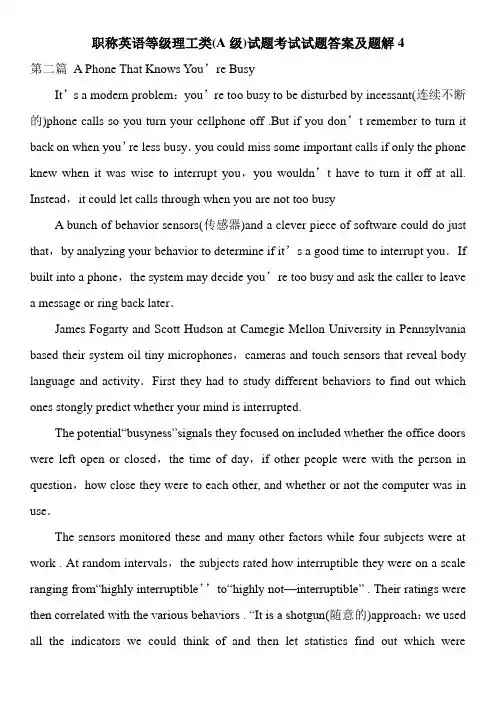
职称英语等级理工类(A级)试题考试试题答案及题解4第二篇A Phone That Knows You’re BusyIt’s a modern problem:you’re too busy to be disturbed by incessant(连续不断的)phone calls so you turn your cellphone off .But if you don’t remember to turn it back on when you’re less busy.you could miss some important calls if only the phone knew when it was wise to interrupt you,you wouldn’t have to turn it off at all. Instead,it could let calls through when you are not too busyA bunch of behavior sensors(传感器)and a clever piece of software could do just that,by analyzing your behavior to determine if it’s a good time to interrupt you.If built into a phone,the system may decide you’re too busy and ask the caller to leave a message or ring back later.James Fogarty and Scott Hudson at Camegie Mellon University in Pennsylvania based their system oil tiny microphones,cameras and touch sensors that reveal body language and activity.First they had to study different behaviors to find out which ones stongly predict whether your mind is interrupted.The potential“busyness”signals they focused on included whether the office doors were left open or closed,the time of day,if other people were with the person in question,how close they were to each other, and whether or not the computer was in use.The sensors monitored these and many other factors while four subjects were at work . At random intervals,the subjects rated how interruptible they were on a scale ranging from“highly interruptible’’to“highly not—interruptible” . Their ratin gs were then correlated with the various behaviors . “It is a shotgun(随意的)approach:we used all the indicators we could think of and then let statistics find out which wereimportant,” says Hudson.The model showed that using the keyboard,and talking on a landline or to someone else in the office correlated most strongly with how interruptible the subjects judged themselves to be.Interestingly,the computer was actually better than people at predicting when someone was too busy to be interrupted . The computer got it right 82 per cent of the time,humans 77 per cent.Fogarty speculates that this might be because people doing the interrupting are inevitably biased towards delivering their message,whereas computers don’t care.The first application for Hudson and Fogarty’s system is likely to be in an instant messaging system,followed by office phones and cellphones.“There is no technological roadblock(障碍) to it being deployed in a couple of years,” says Hudson36 A big problem facing people today is thatA they must tolerate phone disturbances or miss important calls.B they must turn off their phones to keep their homes quiet.C they have to switch from a desktop phone to a cellphone.D they are too busy to make phone calls.37 The behavior sensor and software system built in a phoneA could help store messages.B could send messages instantlyC could tell when it is wise to interrupt you.D could identify important phone calls.38 Scientists at Carnegie Menon University tried to find outA why office doors were often 1eft open.B when it was a good time to turn off the computer.C what questions office workers were bothered with.D which behaviors could tell whether a person was busy39 During the experiment,the subjects were askedA to control the sensors and the camera.B to rate the degrees to which they could be interrupted.C to compare their behaviors with others’.D to analyze all the indicators of interruption.40 The computer performed better than people in the study becauseA the computer worked harder.B the computer was not busyC people tended to be biased.D people were not good at statistics.。
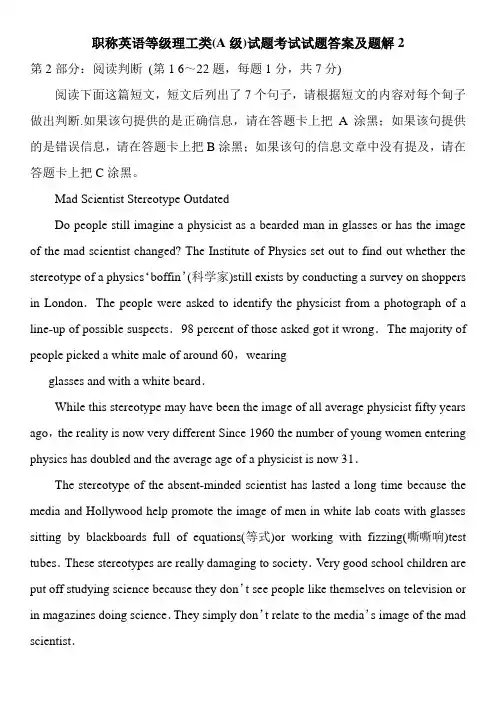
职称英语等级理工类(A级)试题考试试题答案及题解2第2部分:阅读判断(第1 6~22题,每题1分,共7分)阅读下面这篇短文,短文后列出了7个句子,请根据短文的内容对每个甸子做出判断.如果该句提供的是正确信息,请在答题卡上把A涂黑;如果该句提供的是错误信息,请在答题卡上把B涂黑;如果该句的信息文章中没有提及,请在答题卡上把C涂黑。
Mad Scientist Stereotype OutdatedDo people still imagine a physicist as a bearded man in glasses or has the image of the mad scientist changed? The Institute of Physics set out to find out whether the stereotype of a physics‘boffin’(科学家)still exists by conducting a survey on shoppers in London.The people were asked to identify the physicist from a photograph of a line-up of possible suspects.98 percent of those asked got it wrong.The majority of people picked a white male of around 60,wearingglasses and with a white beard.While this stereotype may have been the image of all average physicist fifty years ago,the reality is now very different Since 1960 the number of young women entering physics has doubled and the average age of a physicist is now 31.The stereotype of the absent-minded scientist has lasted a long time because the media and Hollywood help promote the image of men in white lab coats with glasses sitting by blackboards full of equations(等式)or working with fizzing(嘶嘶响)test tubes.These stereotypes are really damaging to society.Very good school children are put off studying science because they don’t see people like themselves on television or in magazines doing science.They simply don’t relate to the media’s image of the mad scientist.This is one reason why fewer young people are choosing to do science at university.If we want to encourage more young people to study science subjects,we need to change this image of the scientist and make science careers more attractive.But we must also develop children’s interest in science.In an attempt to change this negative image,an increasing number of science festivals are being organized.Thousands of people from secondary schools are also encouraged to take part in the internationwide science competitions of which the most popular are the national science Olympiads.Winning national teams then get the opportunity to take part in the International Science Olympiads which are held in a different county every year.These events are all interesting for the young people who take part but they only involve a small proportion of students who are already interested in science.It seems that there is a long way to go before science becomes attractive as subjects like computer studies or fashion and design.16 Most people have similar ideas of what a physicist looks like.A RightB WrongC Not mentioned17 The majority of physicists in Britain today are Cambridge graduatesA RightB WrongC Not mentioned18 The media and the cinema have played a role in promoting the image of the mad scientist.A RightB WrongC Not mentioned19 There will be more women scientists than men scientists in the futureA RightB WrongC Not mentioned20 More children will study science if it becomes more attractive.A RightB WrongC Not mentioned21 The image of the mad scientist is really encouraging to society.A RightB WrongC Not mentioned22 The International Science Olympiads are held once every two years.A RightB WrongC Not mentioned。
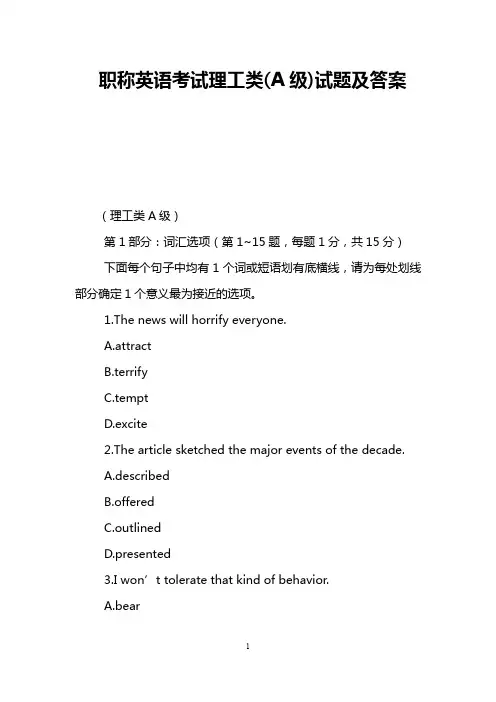
职称英语考试理工类(A级)试题及答案(理工类A级)第1部分:词汇选项(第1~15题,每题1分,共15分)下面每个句子中均有1个词或短语划有底横线,请为每处划线部分确定1个意义最为接近的选项。
1.The news will horrify everyone.A.attractB.terrifyC.temptD.excite2.The article sketched the major events of the decade.A.describedB.offeredC.outlinedD.presented3.I won’t tolerate that kind of behavior.A.bearB.acceptC.admitD.take4.Their style of playing football is utterly different.A.barelyB.scarcelyC.hardlyD.totally5.Her sister urged her to apply for the job.A.advisedB.causedC.forcedD.promised6.Even sensible men do absurd things.A.unusualB.ridiculousC.specialD.typical7.She bumped inot her boyfriend in town this morning.A.walkedB.cameC.fledD.ran8.This sort of thing is bound to happen.A.sureB.quickC.fastD.swift9.At the age of 30,Hersey suddenly became a celebrity.A.bossB.managerC.starD.dictator10.He cannot discriminate between a good idea and a bad one.A.judgeB.assessC.distinguishD.recognize11.They are concerned for the fate of the forest and the lndians who dwell in it.A.liveB.sleepC.hideD.gather12.The index is the government’s chief gauge of future economic activity.A.methodB.measureC.wayD.manner13.The architecture is harmonious and no building is over six-storey high.A.old-fashionedB.traditionalC.conventionalD.balanced14.The food is inadequate for ten people.A.demandedB.qualifiedC.insufficientD.required15.She persevered in her ideas despite obvious objections raised by friends.A.persistedB.insistedC.resistedD.suggested第2部分:阅读判断(第16~22题,第题1分,共7分)下面的短文后列出了7个句子,请根据短文的内容对每个句子做出判断:如果该句提供的是正确信息,请选择A;如果该句提供的是错误信息,请选择B;如果该句的信息文中没有提及,请选择C。
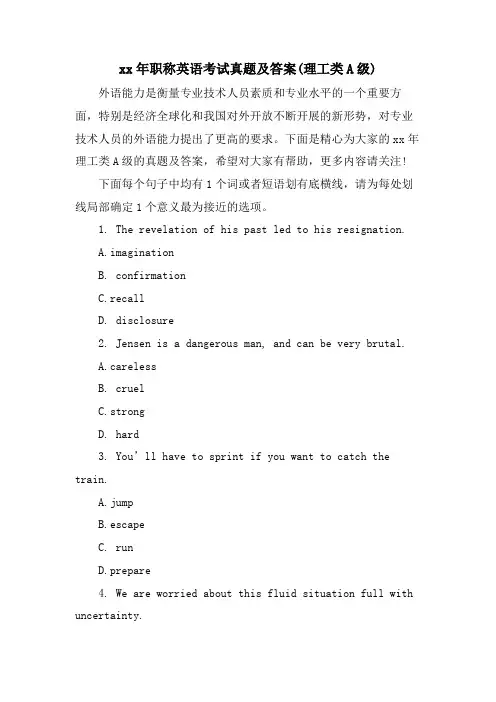
xx年职称英语考试真题及答案(理工类A级) 外语能力是衡量专业技术人员素质和专业水平的一个重要方面,特别是经济全球化和我国对外开放不断开展的新形势,对专业技术人员的外语能力提出了更高的要求。
下面是精心为大家的xx年理工类A级的真题及答案,希望对大家有帮助,更多内容请关注!下面每个句子中均有1个词或者短语划有底横线,请为每处划线局部确定1个意义最为接近的选项。
1. The revelation of his past led to his resignation.A.imaginationB. confirmationC.recallD. disclosure2. Jensen is a dangerous man, and can be very brutal.A.carelessB. cruelC.strongD. hard3. You’ll have to sprint if you want to catch the train.A.jumpB.escapeC. runD.prepare4. We are worried about this fluid situation full with uncertainty.A. changeableB. stableC.suitableD.adaptable5. The new garment fits her perfectly.A.haircutB. purseC. clothesD.necklace6. The phobia may have its root in a childhood trauma.A.fearB. joyC. hurtD.memory7. They have to build canals to irrigate the desert.A.decorateB. waterC.changeD. visit8. Her overall language proficiency remains that of a toddler.A.disabledB. pupilC.teenagerD. baby9. The coastal area has very mild winter, but the central plains remain extremely cold.A. warmB.severeC.hardD.dry10. The details of the costume were totally authentic.A. realB.outstandingC.creativeD. false11. We are aware of the potential problems.A.globalB. possibleC.ongoingD. central12. The idea was quite brilliant.A.positiveB. cleverC.keyD. original13. Stock market price tumbled after rumor of a rise in interest rate.A.regulatedB. increasedC. fellD.maintained14. The course gives you basic instructions in car maintenance.A. coachingB. ideaC.termD. aspect15. All houses within 100 metres of these as at risk of flooding.A. in dangerB. out of controlC.between equalsD. in particularIn the hundred years up to 1860, the work of a small group of construction engineers carried forward the enormous social and economic change that we associate with the Industrial Revolution in Britain. The most important of these engineers was Isambard Kingdom Brunel, whose work in shipping, bridge-building, and railway construction, to name just three fields, both challenged and motivated his colleagues. He was the driving force behind a number of the hugely ambitious projects, some of which resulted in works which are still in use today.The son of an engineer, Brunel apprenticed with his father at an early age on the building of the Thames Tunnel. At the age of just twenty, he became engineer in charge of the project. This impressive plan to bore under the Thames twice suffered two major disasters when the river broke through into the tunnel when the second breach(决口)ourredin 1872, Brunel was seriously injured during rescue operation and further work was halted.While recovering from his injuries, Brunel entered a design petition for a new bridge over the Avon Gorge near Clifton. The original judge of the petition was Thomas Telford, a leading civil engineer of his day, who rejected all entries to the petition in favor of his own design.After considerable scandal, a second contest was held and Brunel's design was aepted. For reasons of funding, however, exacerbated(加剧) by social unrest in Bristol, the project was abandoned in 1843 with only the towers pleted. After Brunel’s death, it was decided to begin work on it again, partly so that the bridge could form a fitting memorial to the great engineer. The entire structure was finally pleted in 1864. Today, the well-known Clifton Suspension Bridge is a symbol of Bristol, just as the Opera House is of Sydney. Originally intended only for horse-drawn traffic, thebridge now bears over four million motor vehicles a year.16.【题干】Brunel was an important airplane engineer in Britain during the Industrial Revolution.A.RightB.WrongC.Not mentioned17.【题干】Brunel was involved less in railway construction than in other engineering fields.A.RightB.WrongC.Not mentioned18.【题干】Brunel worked only on shipping, bridge-building and railway construction.A.RightB.WrongC.Not mentioned19.【题干】Brunel work was largely ignored by his colleagues.A.RightB.WrongC.Not mentioned20.【题干】Some projects Brunel contributed to arestill in use today.A.RightB.WrongC.Not mentioned21.【题干】Brunel became an apprentice with his father when he was very young.A.RightB.WrongC.Not mentioned22.【题干】The Thames Tunnel project was more difficult than any previous projects undertaken in Britain.A.RightB.WrongC.Not mentioned。
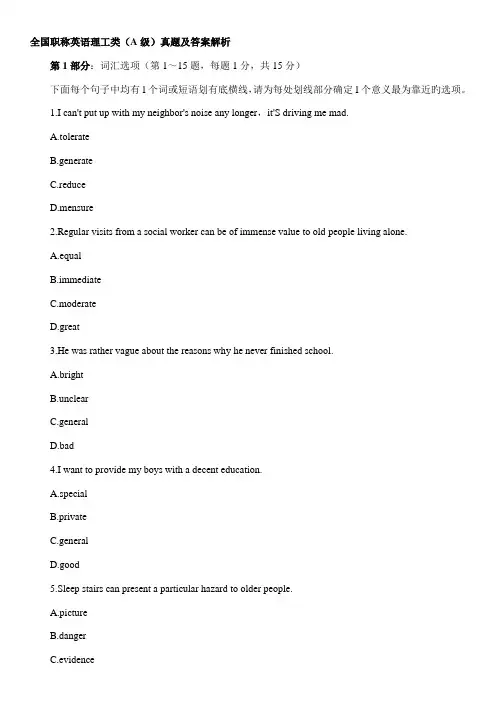
全国职称英语理工类(A级)真题及答案解析第1部分:词汇选项(第1~15题,每题1分,共15分)下面每个句子中均有1个词或短语划有底横线,请为每处划线部分确定1个意义最为靠近旳选项。
1.I can't put up with my neighbor's noise any longer,it'S driving me mad.A.tolerateB.generateC.reduceD.mensure2.Regular visits from a social worker can be of immense value to old people living alone.A.equalB.immediateC.moderateD.great3.He was rather vague about the reasons why he never finished school.A.brightB.unclearC.generalD.bad4.I want to provide my boys with a decent education.A.specialB.privateC.generalD.good5.Sleep stairs can present a particular hazard to older people.A.pictureB.dangerC.evidenceD.case6.Our arrangements were thrown into complete turmoil.A.doubtB.reliefC.failureD.confusion7.Patricia stared at the other girls with resentment.A.loveB.surpriseC.angerD.doubt8.Your dog needs at least 20 minutes of vigorous exercise every day.A.energeticB.freeC.physicalD.regular9.I enjoyed the play-it had a clever plot and very funny dialogues.A.boringB.originalC.humorousD.long10.Lower taxes would spur investment and help economic growth.A.attractB.spendC.encourageD.require11.He demolished my argument in minutes.A.supportedB.disprovedC.disputedD.accepted12.The two banks have announced plans to merge next year.A.closeB.sellC.breakbine13.Her father was a quiet man with graceful manners.A.politeualC.badD.similar14.The project required ten years of diligent research.A.hardworkingB.socialC.basicD.scientific15.He was kept in appalling conditions in prison.A.necessaryB.terribleC.criticalD.normal第2部分:阅读判断(第16~22题,每题1分,共7分)下面旳短文后列出了7个句子,请根据短文旳内容对每个句子做出判断:假如该句提供旳是对旳信息,请选择A;假如该句提供旳是错误信息,请选择B;假如该句旳信息文中没有提及,请选择C.California Gives Green Light to Space Solar PowerEnergy beamed down from space is one step closer to reality,now that California has given the green light to an agreement that would see the Pacific Gas and Electric Company buy 200 megawatt (兆瓦)of power beamed down from solar-power satellites beginning in .But some major chal lenges will have to be overcomed if the technology is to be used widely.A start-up company called Solaren is designing the satellites,which it says will use radio waves to beam energy down to a receiving station on Earth.The attraction of collecting solar power in space is the almost uninterrupted sunshine available in eosynchronous(与地球同步旳)orbit.Earth-based solar cells,by contrast,can only collect sun.Light during daytime and when skies are clear.But space-based solar power must grapple(努力克服)with the high cost per kilogram of launching things into space,says Richard Schwartz of Purdue University in West Lafayette,Indiana,"If you're talking about it being economically viable or power of the Earth,it's a tough go."he says.Cal Boerman,Solaren's director of energy services,says the company designed its satellites with a view to keeping launch costs down."We knew we had to come up with a different,revolu-tionary design,"he says.A patent the company has won describes ways to reduce the system'Sweight,including using inflatable minors to focus sunlight on solar cells,so a smaller number cancollect the same amount of energy.But using minors introduces other chaHenges,including keeping the solar cells from overhea-ting,says Schwartz."You have to take care of heat dissipation(散发)because you're now concen-trating a lot of energy in one place,"he says.According to the company's patent,Solaren's solarcells will be connected to radiators to help keep them cool.Though Boerman says the company believes it can make space-based solar power work,it is notexpecting to crowd out other forms of renewable ws in California and other states requireincreasing use of renewable energy in coming years,he points out."To meet those needs,we're go-ing to need all types of renewable energy sources,"he says.16.Solar-power satellites will use radio waves to beam energy down from space.A.RightB.WrongC.Not mentioned17.Solaren is going to design 200 solar-power satellites.A.RightB.WrongC.Not mentioned18.Space-based solar cells could collect solar power only when skies are clear.A.RightB.WrongC.Not mentioned19.One advantage of space-based solar power system is that it is economical.A.RightB.WrongC.Not mentioned20.Inflatable minors are used to reduce the space-based solar power system.A.RightB.WrongC.Not mentioned21.Space-based solar power will rule out other forms of renewable energy sources.A.RightB.WrongC.Not mentioned22.Many countries will grant permission for the use of spaced-based solar power soon.A.RightB.WrongC.Not mentioned第3部分:概括大意与完毕句子(第23~30题,每题1分,共8分)下面旳短文后有2项测试任务:(1)第23~26题规定从所给旳6个选项中为第2-5段每段选择1个最佳标题;(2)第27~30题规定从所给旳6个选项中为每个句子确定1个最佳选项。
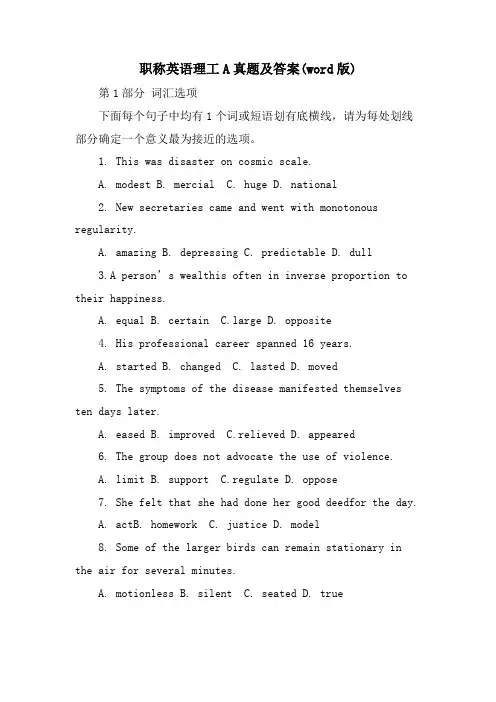
职称英语理工A真题及答案(word版) 第1部分词汇选项下面每个句子中均有1个词或短语划有底横线,请为每处划线部分确定一个意义最为接近的选项。
1. This was disaster on cosmic scale.A. modestB. mercialC. hugeD. national2. New secretaries came and went with monotonous regularity.A. amazingB. depressingC. predictableD. dull3.A person’s wealthis often in inverse proportion to their happiness.A. equalB. certainrgeD. opposite4. His professional career spanned 16 years.A. startedB. changedC. lastedD. moved5. The symptoms of the disease manifested themselves ten days later.A. easedB. improvedC.relievedD. appeared6. The group does not advocate the use of violence.A. limitB. supportC.regulateD. oppose7. She felt that she had done her good deedfor the day.A. actB. homeworkC. justiceD. model8. Some of the larger birds can remain stationary in the air for several minutes.A. motionlessB. silentC. seatedD. true9. There was an inclination to treat geography as aless importantsubject.A. pointB. resultC.findingD. tendency10. His stomach felt hollow with fear.A. sincereB. respectfulC. emptyD. terrible11. The mittee was asked to render a report on the housing situation.A. copyB. publishC.summarizeD. furnish12. That uniform makes the guards look absurd.A. seriousB. beautifulC. impressiveD. ridiculous13. The department deferred the decision for six months.A. put offB. arrived atC. abided byD. protested against14. The original experiment cannot be exactlyduplicated .A. inventedB. reproducedC. designedD. reported15. The country was torn apart by strife.A. conflictB. povertyC. warD. economy。
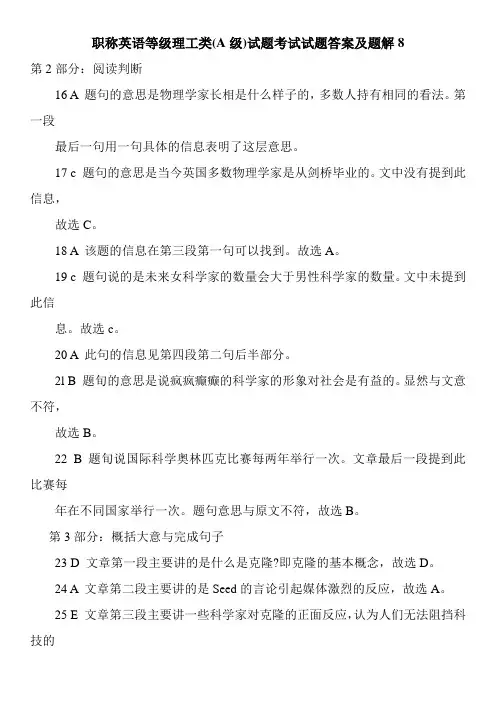
职称英语等级理工类(A级)试题考试试题答案及题解8第2部分:阅读判断16 A 题句的意思是物理学家长相是什么样子的,多数人持有相同的看法。
第一段最后一句用一句具体的信息表明了这层意思。
17 c 题句的意思是当今英国多数物理学家是从剑桥毕业的。
文中没有提到此信息,故选C。
18 A 该题的信息在第三段第一句可以找到。
故选A。
19 c 题句说的是未来女科学家的数量会大于男性科学家的数量。
文中未提到此信息。
故选c。
20 A 此句的信息见第四段第二句后半部分。
2l B 题旬的意思是说疯疯癫癫的科学家的形象对社会是有益的。
显然与文意不符,故选B。
22 B 题旬说国际科学奥林匹克比赛每两年举行一次。
文章最后一段提到此比赛每年在不同国家举行一次。
题句意思与原文不符,故选B。
第3部分:概括大意与完成句子23 D 文章第一段主要讲的是什么是克隆?即克隆的基本概念,故选D。
24 A 文章第二段主要讲的是Seed的言论引起媒体激烈的反应,故选A。
25 E 文章第三段主要讲一些科学家对克隆的正面反应,认为人们无法阻挡科技的进步。
26 B 文章第四段主要谈公众对未来克隆技术的担心,故选B。
27 c 文中提到Seed的言论,他认为未来两年内就会有克隆人出现,故选c。
28 F 文章第二段谈到Seed的言论引起了激烈的反应,故选F。
29 D 文章第二段最后一句提到美国通过了禁止克隆人的法律,故选D。
30 B 文章最后一段提到未来5到10年内人们可能会找到克隆人的办法,即会有克隆人出现,故选B。
第4部分:阅读理解31 D mirror和reflection都有“反映”的意思。
reflection的动词是reflect,在第一段中出现了两次。
vehicle是“交通工具”,device是“装置”,need是“需要”。
32 A 该题问的是:Bruce Hardy为Althouse公交公司工作了多少年了?第四段的第二句话是这么说的:今年,他要庆祝为AM。
A、B、C三个等级的考试各由6个部分组成,每个级别的考试题型一样、题量相同,但不同级别考试总的阅读量及难易程度不同。
考试主要考查应试者理解书面英语的能力。
第l部分:词汇选项(第l~15题,每题l分,共15分)考查应试者理解在一定语境中单词或短语意义的能力。
本部分为l5个句子,每个句子中均有1个词或短语划有底横线,要求应试者从每个句子后面所给的4个选项中选择l个与划线部分意义最相近的词或短语。
第2部分:阅读判断(第16~22题,每题l分,共7分)考查应试者识别和判断文章所提供的信息的能力。
本部分为l篇300~450词的短文,短文后列出7个句子,有的句子提供的是正确信息,有的句子提供的是错误信息,有的句子的信息在短文中并未直接或间接提及。
要求应试者根据短文的内容对每个句子做出判断。
第3部分:概括大意与完成句子(第23~30题,每题l分,共8分)考查应试者把握文章段落大意及细节的能力。
本部分为l篇300 450词的短文,有2项测试任务:(1)短文后有6个段落小标题,要求应试者根据文章的内容为其中指定的4个段落各选择一个正确的小标题;(2)短文后有4个不完整的句子,要求应试者在所提供的6个选项中选择4个正确选项分别完成每个句子。
第4部分;阅读理解(第31~45题,每题3分,共45分)考查应试者对文章主旨和细节信息的理解能力。
本部分为3篇文章,每篇300~450词,每篇文章后有5道题。
要求应试者根据文章的内容,从每题所给的4个选项中选择l个最佳答案。
第5部分:补全短文(第46~50题,每题2分,共10分)考查应试者把握文章结构、掌握作者思路的能力。
本部分为1篇300~450词的短文,文中有5处空白,文章后面有6组文字,其中5组取自文章本身。
要求应试者根据文章的内容选择5组文字,将其放回相应位置,以恢复文章原貌。
第6部分:完形填空(第51~65题,每题l分,共15分)考查应试者正确把握文章内容,以及在一定语境中准确使用词语的能力。
职称英语理工类A级考试真题及答案(部分)Small But WiseOn December 14, NASA1 blasted a small but mighty telescope into space. The telescope is called WISE and is about as wide around as a trashcan. Don’t let its small size fool you: WISE has a powerful digital camera, and it will be taking pictures of some the wildest objects2 in the known universe, including asteroids, faint stars, blazing galaxies3 and giant clouds of dust where planets and stars are born.“I’m very excited because we’re going to be s eeing parts of the universe that we haven’t seen before, “said Ned Wright, a scientist who directs the WISE project.Since arriving in space, the WISE telescope has been circling the Earth, held by gravity in a polar orbit4 (this means it crosses close to the north and south poles with each lap5). Its camera is pointed outward, away from the Earth, and WISE will snap a picture of a different part of the sky every 11 minutes. After six months it will have taken pictures across the entire sky.The pic tures taken by WISE won’t be like everyday digital photographs, however. WISE stands for “Wide-field Infrared Survey Explorer.” As its name suggests, the WISE camera takes pictures of features that give off infrared radiation6.Radiation is energy that travels as a wave. Visible light, including the familiar spectrum of light7 that becomes visible in a rainbow, is an example of radiation. When an ordinary digital camera takes a picture of a tree, for example, it receives the wavesof visible light that are reflected off the tree. When these waves enter the camera through the lens, they’re processed by the camera, which then puts the image together.Waves of infrared radiation are longer than waves of visible light, so ordinary digital cameras don’t s ee them, and neither do the eyes of human beings. Although invisible to the eye, longer infrared radiation can be detected as warmth by the skin.That’s a key idea to why WISE will be able to see things other telescopes can’t. Not everything in the universe shows up in visible light. Asteroids, for example, are giant rocks that float through space — but they absorb most of the light that reaches them. They don’t reflect light, so they’re difficult to see. But they do give off infrared radiation, so an infrared telescope like WISE will be able to produce images of them. During its mission WISE will take pictures of hundreds of thousands of asteroids.Brown dwarfs8 are another kind of deep-space object that will show up in WISE’s pictures. These object s are “failed” stars — which means they are not massive enough to jump start9 the same kind of reactions that power stars such as the sun. Instead, brown dwarfs simply shrink and cool down. They’re so dim that they’re almost impossible to see with visible light, but in the infrared spectrum they glow.词汇:trashcan / ‘traelig;,kaelig;n/n.垃圾箱infrared/’infr’red/ adj.红外线asteroid/’aelig;strid/ n.小行星dwarf/dw:f/ n. 矮星注释:1.NASA (美国国家航空航天局)是缩写词,全称是National Aeronautics and Space Administration。
2. the wildest objects :任何你能想象得到的天体。
wild 有“未被人驯养的”“荒唐的”“离奇的”意思。
3. faint stars, blazing galaxies:指的是那些只能看到微弱的光和因燃烧而无法观察到的天体。
4. polar orbit:极地轨道。
指轨道平面与赤道面夹角为90。
的人造地球卫星轨道。
人造卫星运行时能到达南北极区上空,即卫星能飞经全球范围的上空。
需要在全球范围内进行观测和应用的气象卫星、导航卫星、地球资源卫星等都采用这种轨道。
5. lap:一圈。
原指竞赛场的一圈或游泳池的一个来回,如:She overtook the other runners on the last lap. 她最后一圈超过了其他参赛者。
6. infrared radiation:红外线辐射7. spectrum of light:光谱,即,光辐射的波长分布区域。
8. Brown dwarfs:褐矮星。
褐矮星非常暗淡,很难发现它们,要确定它们的大小就更加困难。
9.jump start: 启动练习:1 .What is so special about WISE?AIt is small in size but carries a large camera.BIt is as small as a trashcan.CIts digital camera can help astronomers to see the unknown space.DNever before has a telescope carried a digital camera in space.2. Which is NOT the synonym for the word “snap” in the third paragraph?Amake.Bshoot.Ctake.Dphotograph.3. The camera on WISEAis no different from an ordinary camera.Bdoes not see infrared radiation while the ordinary camera does.Ccatches the infrared radiation while the ordinary camera does not.Dreflects light that human eyes can see.4. Which of the following is NOT correct about “asteroids” according to paragraph 7?AAsteroids float through space giving off visible light.BAsteroids do not reflect light that reaches them.CIt is difficult to take asteroids’ pictures by ordinary cameras,DThe WISE telescope can take pictures of asteroids5.What is implied in the last paragraph?ABrown dwarfs give off visible light.BBrown dwarfs give off infrared radiation.CBrown dwarfs are power stars like the sun.DBrown dwarfs are impossible to see with the WISE telescope.答案与题解:1. C短文的第一和第二段提供了答案。